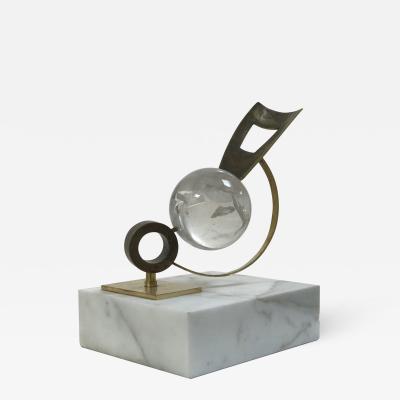Black and Red Figure Vases
In the ancient Greek world, a largely illiterate society sought to understand and explain unknown forces and the vicissitudes of daily life through mythological gods and the heroes that embodied divine power—their deeds and images were interpreted in the constellations in the night sky, in homes and shrines, and on jewelry and objects of everyday use. Among the most recognizable outlets of this cultural expression are the black- and red-figure pottery vases on which gods and heroes fought, caroused, loved, and reenacted the myths and legends of the classical psyche.
The earliest Greek vases were made of clays that varied in color depending on the region in which they were made. Corinthian potters of the 7th century B.C. were the first Greeks to embellish their vases with what is known as the black-figure style of painting, a decorative treatment following Near Eastern prototypes depicting animals in profile. Athenian artists began to copy the Corinthian format by the beginning of the 6th century B.C., frequently replacing one of the animal registers with a depiction of one of the myths of Herakles, most often represented with the skin from the lion he slew. Gradually, the registers diminished until one large scene filled an entire side. As Athens is the capital of Attica, these Athenian vases are referred to as Attic wares.
Due to the method of painting and firing, many decorated vessels are found in the exact state as when first fashioned. The process involved applying a clay and water slip to the pot after it dried to a leather-hard state, after which the pot was fired. While in the kiln, a chemical reaction occurred that bound the paint to the clay, resulting in permanent decoration that did not flake or fade over time. Images were given further permanence and enhanced details by the addition of incised lines.
Many black-figure vases have only one main scene painted on the front and then two or three standing figures painted by a less-skilled hand on the reverse. The amphora of circa 530–520 B.C. (illustrated in Figs. 1 and 2) is unusual in that both the front and back show the work of a master. The scene in Figure 1 illustrates the myth of the Athenian prince Theseus killing the Minotaur, a bull-headed monster, in the maze beneath the palace of King Minos of Crete. On the reverse (Fig. 2), Apollo, god of music and mystery, plays his kithara, or lyre, for the appreciation of Dionysos, god of wine and drama, and Hermes, messenger of the gods.
So popular was this decorative pottery that Athens became the dominant center in pottery exports from Spain to the Crimea and south again to Europe. Nowhere were these black-figure vases more desired than in Italy. One of its indigenous peoples, the Etruscans purchased large quantities of these vessels for use in their homes as well for interment with their dead in elaborate underground tombs. Etruscan workshops emulated the Attic vases, but never replaced them in popularity, in part due to the differences in quality.
By about 530 B.C., experimentation with decorating techniques led to the creation of the red-figure vases. On these vases, the background is black and the figures and decoration are red. Some painters had long careers and worked in both black- and red-figure techniques. New ideas were shared among workshops along the Kerameikos, the Athenian street where the vase makers and painters were situated.
Concurrently, more complicated scenes appeared, with writhing figures in the midst of action rather than posed as before. The elaborate imagery was developed in tandem with more fluid lines in the brush strokes and colors, added after firing, to heighten dimensionality. With improved slip mixtures and by varying the amount of water in the slip, subtle shading of musculature was now possible. The relief line was developed to add definition to the composition, replacing the incised lines of the black-figure vases. This detail is evident in Figure 3—a fragment in the early red-figure style depicting a reclining nude male; the diluted glaze delineates his abdominal muscles, whereas relief lines can be seen on his lower torso and legs.
The stylistic development of the red-figure vases coincides to a large extent with the flowering of ancient Greek culture, art, and philosophy in the late 6th and early 5th centuries B.C. About 450 B.C., Greek sculptor Polykleitos set forth a treatise wherein he described his theories of proportion and the human form. To support his assertions, he carved the “doryphoros” (spear carrier), a statue that was considered proportionately perfect and was hailed as the canon of human form and ideal beauty. The doryphoros influenced the arts from sculpture to vase painting. Heroes like Herakles and gods like Apollo and Ares were modeled on the perfected bodies of athletes. As such, the athletes of the gymnasium in a sense became gods. The vase painters participated in this stylistic development, even mentioning the sculpted youths by name in the vase decoration. Although few of these artists signed their work, many wares are grouped by the names of admired young athletes, such as Leagros; no fewer than ten vase painters inscribed his name on their work.
By about 450 B.C., Athenian artists set up the first workshops in southern Italy. As Greek dominance expanded up the Italian peninsula, more workshops appeared, and the center of vase production shifted from Athens to the colonies established in Italy. By the early 4th century B.C., the Italian regional styles, now known as Lucanian, Apulian, Campanian, Paestan, and Sicilian, could be readily identified. The stylistic progression of both the Attic and South Italian pottery developed apace until the end of the century exhibiting what might be called a baroque style—vase surfaces completely covered with figures, scrolls, palmettes, meanders, applied heads, and additional pastel colors. Such embellishments are evident in Figures 4 and 5, which illustrate a large red-figure krater, a vessel in which wine and water were mixed. This vase was painted circa 400–370 B.C. by a southern Italian painter from the Dirce Workshop. The Thracian bard Thamyris is seen on the front, blinded and seated upon a rock, his lyre leaning against it; at right and above, the Muses, goddesses of the arts, are gloating. Thamyris had boasted that he was the greatest musician ever to live, even more skilled than the Muses, whereupon they took away his sight and caused him to forget his skill. On the reverse, Kadmos, founder of Thebes, slays a dragon whose teeth then become the men of Thebes.
Athens’ golden age ended with its defeat in the Peloponnesian War in 404 B.C. A new power to the north, Macedon, united the Greek peninsula with the rest of the known world under the rule of Alexander the Great (356–323 B.C.). By the turn of the 3rd century B.C., even the Italian satellite workshops had stopped producing figural pottery. A more rapidly manufactured black-glazed ware, decorated after firing with pigments in perfunctory geometric designs or with grape arbors and occasional painted figures, became the norm. Not until the Renaissance would painted figural pottery reappear.
Popes and cardinals of the Renaissance, being near the source, contributed to a rekindled interest in classical vases when they amassed the first sculpture galleries that would form the Vatican collections of today. But it was an Englishman, Sir William Hamilton (1730–1803), who in his capacity as British envoy to the Court of Naples contributed to the popularization of classical painted vases. While in Italy, Hamilton assembled a vast collection of sculpture and pottery, and in the 1760s he commissioned several artists to make engravings of the scenes and hand-color them. Hamilton’s desire was to sell the collection of vases, which eventually went to the British Museum. The vases served as models for the work of local potters such as Josiah Wedgwood and began a collecting frenzy that would make the museum one of the world’s greatest repositories of Greek art.
Over the past century, an increase in scholarship has led to categorizing, comparing, attributing, and publishing thousands of vases still in existence, such that this field is now one of the most accessible to the collector as well as the academic student. Collecting these beautiful vases does require some caution, however. Always seek the advice of a reputable dealer. Forgeries exist, and there are international laws protecting the traffic in antiquities. Always request a written guarantee that the object you are acquiring is genuine and that it conforms to the cultural property guidelines set forth in the UNIDROIT Convention on Stolen or Illegally Exported Cultural Objects. Further research should entail contacting the Art Loss Register, based in New York, London, and Cologne (www.artloss.com).
The value of ancient Greek vases is determined by theme, artist, shape, and, to a lesser degree, condition (remember that these vases are at least 2,300 years old—chips, reasonable repairs, and minor restorations are acceptable). Set your budget and stick to it; vases range in price starting at about $1,000 for the late, small examples, from $25,000 to $100,000 for fine museum-quality work, and up to $1,000,000 or more for kraters by Athenian master Euphronios. There are still many choice vases in the $15,000 range. The most desirable themes are myths—the more obscure, the better. Vases depicting the Labors of Herakles were popular when they were made and, therefore, are relatively numerous and easily attained. Other depictions favored in ancient times include scenes from the Trojan War as well as the lovers and victims of the gods. On wine vases, such as amphora, the most frequently depicted god is Dionysos with his entourage of satyrs and maenads.
Never be too intimidated to discuss your interests, concerns, or inexperience with a dealer, as he or she will appreciate the serious manner in which you approach the field. Many will encourage your learning by providing reference materials and photographs to carry with you when visiting museums for comparison. As you continue to learn about black- and red-figure vases, you will become as captivated as collectors and scholars have for centuries.
-----
Suggested Reading:
Boardman, John. Thames & Hudson.
Athenian Black-Figure Vases. 1974.
Athenian Red-Figure Vases: The Archaic Period. 1975.
Athenian Red-Figure Vases: The Classical Period. 1989.
Bron, Berard et al. A City of Images. Princeton University Press, 1989.
Moon, Warren G. Greek Vase-painting in Midwestern Collections. Art Institute of Chicago, 1979.
Schreiber, Tony. Athenian Vase Construction. Getty, 1999.
Trendall, Dale A. Red-Figure Vases of South Italy and Sicily—A Handbook. Thames & Hudson, 1989.
-----
Jerome M. Eisenberg, Ph.D., is the founder and director of Royal-Athena Galleries in New York. A specialist in ancient art for forty years, he has lectured worldwide on antiquities, published numerous papers, and served as an expert appraiser for museums and the federal government.

















je.jpg)


















